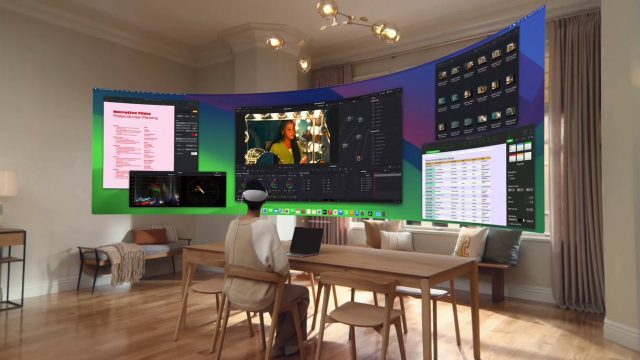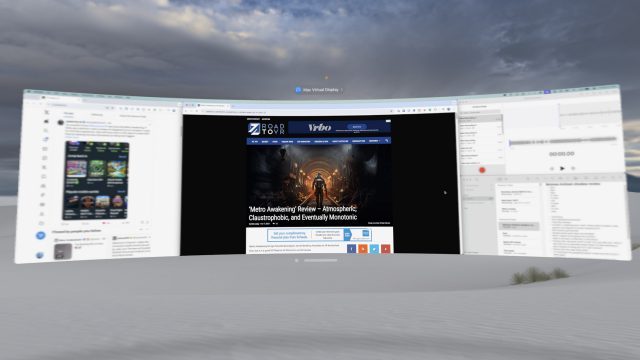Students can gain a deeper understanding of complex subjects through storytelling-driven technology, says Aundrea Frahm, director of immersive learning.
As the inaugural director of immersive learning initiatives, Aundrea Frahm is helping to shape the future of learning at UNLV. Her mission is to leverage cutting-edge technologies such as virtual reality (VR), augmented reality (AR), and mixed reality (MR) to transform how students experience education.
The goal? Create dynamic, interactive environments that captivate students, deepen understanding, and prepare them for a rapidly evolving world.
With a background in fine arts, creative directing, and education technology, Frahm brings a unique perspective to the role. Her creative approach to problem-solving and collaborative mindset makes her an invaluable resource for faculty as they explore new ways to integrate immersive technologies into their teaching.
As UNLV’s new Dreamscape Learn space at Lied Library nears completion, Frahm has been working with the first cohort of faculty to incorporate these tools into courses. The space will open to the UNLV campus community in the summer with class modules being taught in the space in the fall semester. In spring 2026, it will be open to the greater Las Vegas community.
The Dreamscape Learn initiative was launched by President Keith E. Whitfield and is a collaborative effort through University Libraries, the Office of Teaching and Learning Innovation, and the Office of Information Technology.
Here Frahm shares her vision for immersive learning at UNLV and the role of the soon-to-open space.
Can you tell us what immersive learning is and how it’s used in higher education?
Immersive learning leverages emerging technologies like VR, AR, and MR to enhance traditional teaching methods. Through these extended realities, students experience kinesthetic learning, increase retention, and gain a deeper understanding of complex concepts.
The applications for these technologies are vast — architecture students can virtually visit historic sites, biology students can safely practice examination tests, and art students can view famous sculptures as if they were right in front of them.
Today’s students are deeply connected to technology and its rapid evolution. Therefore, higher education institutions must adapt and embrace these emerging technologies.
How will the new Dreamscape Learn immersive learning space support this work?
At UNLV, we’re pioneering immersive learning initiatives through Dreamscape Learn, an initiative of President Keith E. Whitfield. Coupled with state-of-the-art audio and video production facilities, we are creating a dynamic learning environment where technology and creativity converge.
Dreamscape Learn is a key component of our learner-centered approach, leveraging the power of interactivity and storytelling within immersive environments. By transporting students to these virtual reality worlds, we free them from distractions and ignite their curiosity, allowing them to become explorers and knowledge seekers accessing experiences that might otherwise be out of reach.
This resonates deeply with today’s students, who have grown up immersed in digital worlds. Repurposing these technologies for education unlocks immense potential, particularly in challenging subjects like STEM.
Why is UNLV the perfect location for this type of immersive learning education?
There is no better place for Dreamscape Learn than at UNLV. Located in Las Vegas, the Entertainment Capital of the World, we embrace the idea that entertainment enriches education. This concept can serve as the foundation for a broader immersive learning initiative that distinguishes UNLV as a leader in innovation and technological advancements.
What benefits do students receive from using this type of immersive learning?
By blending virtual reality with cinematic storytelling, the platform allows students to explore complex concepts through interactive, story-driven environments. The learning is tangible and memorable. These experiences not only captivate students, but also foster deeper understanding and encourage active participation, helping them retain information while sparking genuine curiosity.
Dreamscape Learn also increases motivation and accessibility. Its immersive format turns learning into an adventure, making even challenging subjects more engaging and approachable. Students who face barriers to traditional education — whether physical, logistical, or cognitive — gain the opportunity to interact with lessons in innovative ways. Dreamscape Learn equips students with critical thinking, collaboration, and technical skills, preparing them for success in an increasingly technology-driven world.
I think this approach really embodies UNLV’s Top Tier 2.0 dedication to building an inclusive, vibrant, and transformative academic community.
What types of courses/subjects could benefit from immersive learning?
Almost all courses and subjects can benefit from immersive learning. With Dreamscape Learn specifically, programs that could benefit include biology, art history, architecture, engineering entertainment and design, film, and many others.
How will your background in fine arts and sculpture help you work with faculty on developing these courses?
After a decade of collegiate experience, I understand the faculty perspective of what it takes to integrate new technologies and theories into classes. They are the first to know exactly how extended realities could best be used in their curriculums. Already, I have met with many faculty members on campus and am increasingly impressed with their passion and ideas for utilizing immersive technologies.
As a creative individual, my mind is continually working through how to troubleshoot problems and find solutions. Artists, in general, are highly underutilized in our current society. They often are able to solve complex problems through varied solutions, like facets of a diamond. They usually have a wide breadth of skills, and work well collaboratively.
I am excited to be a builder here at UNLV and to find the many facets that UNLV can benefit from and be propelled through immersive learning.
Can you tell us about some of the virtual reality and augmented reality initiatives you lead for the Utah System of Higher Education?
During my time at Southern Utah University, I served as the director of VR/AR and the primary investigator overseeing nearly a million-dollar grant to establish a virtual and augmented reality program. Together with an exceptional team of student workers, we launched:
- An innovation studio that offers students, faculty, and staff access to various headsets and advanced development computers for software creation.
- A unique VR classroom featuring 23 Meta Quest 3 headsets and compatible 32” TVs, allowing for simultaneous operation. This classroom supports over 30 applications and could be reserved for use.
- The first-ever VR/AR faculty cohort, consisting of nearly 30 professors from various departments, who incorporated VR/AR technologies into over 50 courses, impacting more than 4,000 students. Their classes utilized the VR/AR Classroom for curriculum applications, and pre- and post-data is currently being compiled.
- The conceptualization and execution of the national XR Southern Summit, a conference that brings together industry professionals, educators, higher education students, and XR enthusiasts to exchange ideas and foster collaboration.
- A dedicated content development team of student workers and staff created three custom VR applications from faculty ideas for use in their classes.
What are you most looking forward to working on as you prepare for the official launch of the immersive learning lab and classroom?
Many people view virtual reality primarily as a gaming tool. However, I’m eager to demonstrate to our campus that immersive learning offers much more than mere entertainment. It serves as a valuable asset for enhancing education and can be applied in various contexts. With Dreamscape Learn’s enterprise-level VR, we will establish a vital foundation for a broader immersive learning vision at UNLV.
Quelle:
Foto: Dreamscape Learn is a key component of the space’s learner-centered approach, leveraging the power of interactivity and storytelling within immersive environments. (Aaron Mayes/University Libraries)
https://www.unlv.edu/news/article/where-technology-and-creativity-converge-learning-immersive-spaces


